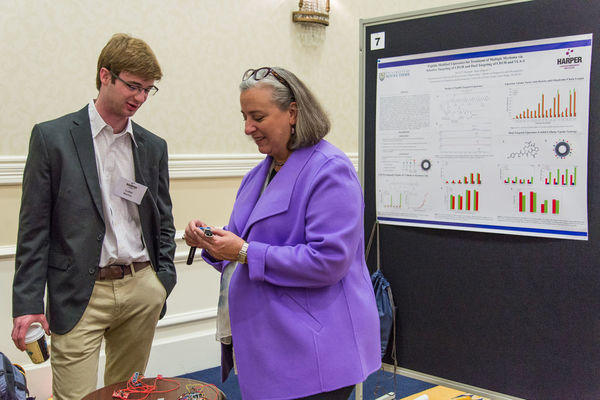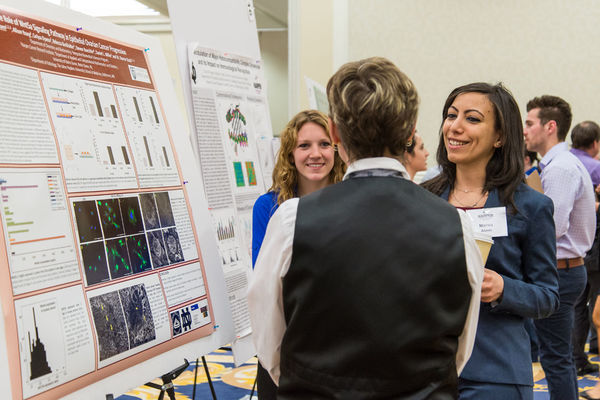Our vision at the HCRI is to be a preeminent cancer research institute that effectively combines research, education and outreach to address the major challenges in cancer research, provide training opportunities for the next generation of oncology researchers, and to serve the greater good in the global community. It is by intentional design that the central pillar of our vision statement is the education of our trainees.
Since our foundation, over 1000 research trainees ranging from high school students to post-doctoral fellows have made hands-on contributions to cancer research in a diversity of HCRI labs. University of Notre Dame undergraduates and graduate students comprise the largest group of HCRI researchers-in-training. Undergraduates use a variety of mechanisms to find a laboratory home, ranging from word-of-mouth, browsing faculty websites, and contacting professors that they meet in class. Each laboratory has a unique training environment and training philosophy and opportunities exist for both complete novices and more seasoned lab workers. For graduate students, who will spend long hours over multiple years developing and completing a project, taking the time to choose the right mentor and laboratory environment helps to ensure long term success.
At HCRI, collaboration is a foundational principle. Our goal is to encourage our research trainees to think independently and to work collaboratively. Recognizing the inherent complexity of cancer, this team-based approach draws on the strengths of all disciplines, integrating disparate tools and methods to provide unique insights. We have developed several programs to encourage such ‘innovation through integration’, made possible through generous philanthropic support to HCRI, including the Research Like a Champion (RLAC) program and the Interdisciplinary Interface Training Project (IITP).

The RLAC program is based on the principle of “students driving innovation in cancer research”. Students are encouraged to contact peers and brainstorm ideas - the more revolutionary, the better - that can be tackled by their research team. Projects need not be laboratory based: devices, apps, interventions... all ideas are welcome in the RLAC program. Current projects span an exciting spectrum of topics. A team led by Luke Maillie (Physics ’18), working with healthcare providers in rural Tanzania, is using complex network analysis to analyze communications between healthcare workers and patients to improve referral rates and monitoring of pediatric cancer patients. Cancer treatment disparities are found in many disadvantaged communities, including those in rural Indiana. Juan Cisneros (ESTEEM master’s program ’18) and his RLAC team are using geospatial technologies to identify high-risk clusters of lung cancer cases in rural Indiana, providing a necessary first step to developing behavioral and clinical interventions. Lord Boachie (Science Pre-Professional ’19) has a new approach to 3D printing - using living cancer cells. In collaboration with a team in the Notre Dame Integrated Imaging Facility, Lord is printing 3D biomodels of breast cancer to aid in the screening of new cancer drugs. In another lab-based project, Marwa Asem (IBMS PhD program ’19) and Carlysa Oyama (Pre-professional Studies ’18) have joined forces to investigate tunneling nanotubes (TNTs). They have discovered that these nanoscale structures form between ovarian cancer cells and normal cells in the abdominal cavity, providing a tiny pathway for energy transfer from the ‘host’ to the growing tumor.

The IITP, supported by the Walther Cancer Foundation, enables graduate student awardees to focus 100% of their efforts on research. A requirement of the IITP program is that the student have joint mentorship by faculty from two distinct disciplines. This enables the student to gain new perspectives that enhance the training experience. For example, Patti Schnepp (IBMS PhD ’17) worked with mentors Dr. Siyuan Zhang (Biological Sciences) and Dr. David Hoelzle (Mechanical & Aerospace Engineering, Ohio State) on her IITP project to understand how breast cancer cells that metastasize to the brain alter their metabolic needs to thrive in the brain microenvironment. Using a variety of classical tumor biology methods together with advanced imaging, next generation sequencing and extensive bioinformatics analyses, Patti made a unique discovery. Her work showed that brain metastatic cells express an enzyme commonly produced by neurons, identifying a potential new target to block brain metastasis. Another metastatic microenvironment, in this case the bone, is being evaluated by bioengineering IITP graduate student Kim Curtis (AME ’19). Working with mentors Dr. Glen Niebur (Aerospace & Mechanical Engineering) and Dr. Laurie Littlepage (Chemistry & Biochemistry), Kim is developing methods to keep bones alive and mechanically stimulated in long term culture. This novel approach is enabling studies to elucidate mechanisms that regulate dormancy of bone-metastatic breast cancers. As successful escape from dormancy leads to painful and life-threatening bone damage, this model system will allow the team to determine how to therapeutically regulate tumor dormancy.
Whether they ultimately pursue careers in academic or biotechnology research, public policy or patent law, healthcare or consulting, education or outreach, HCRI investigators are dedicated to producing the next generation of cancer research leaders!